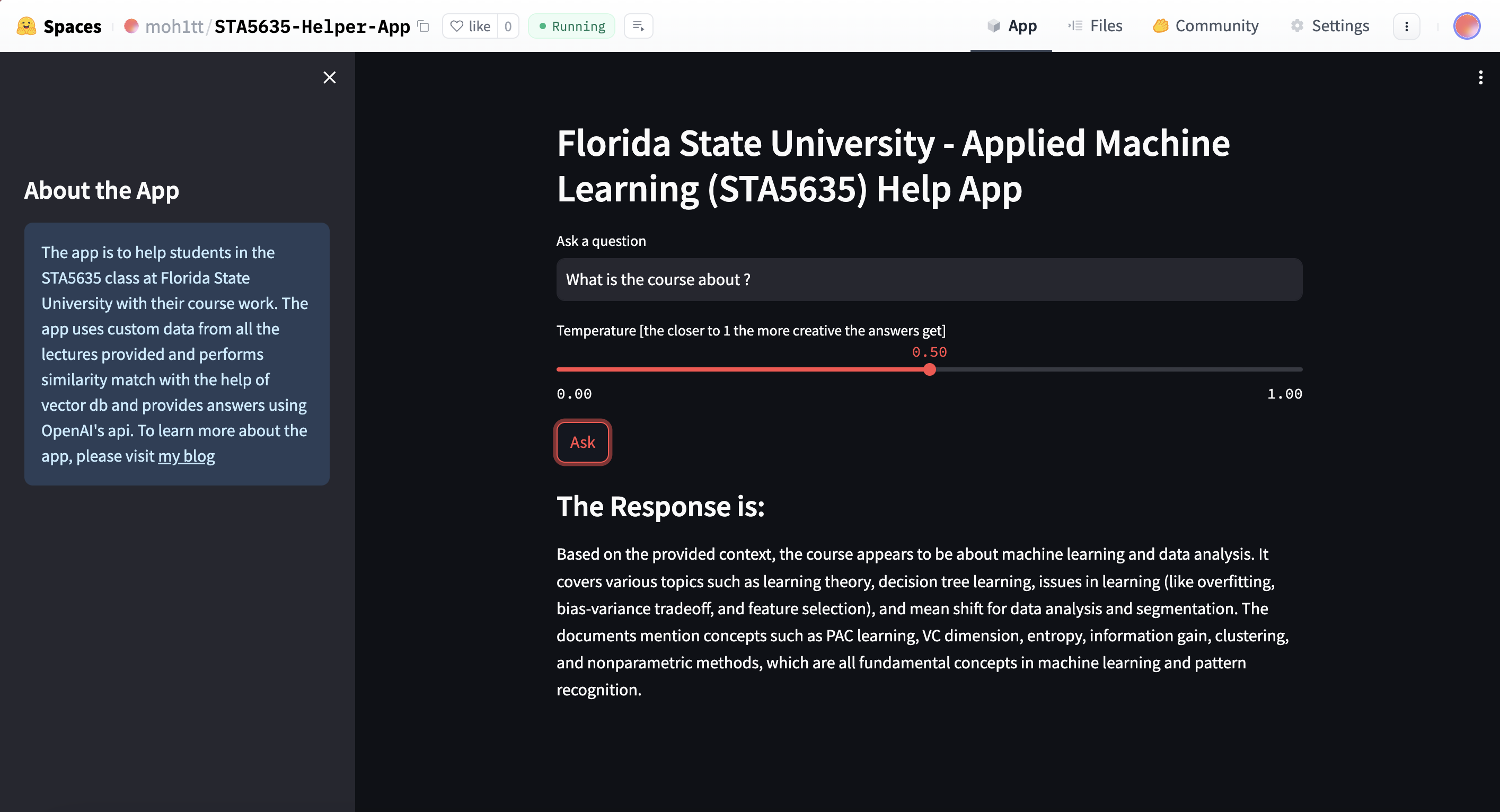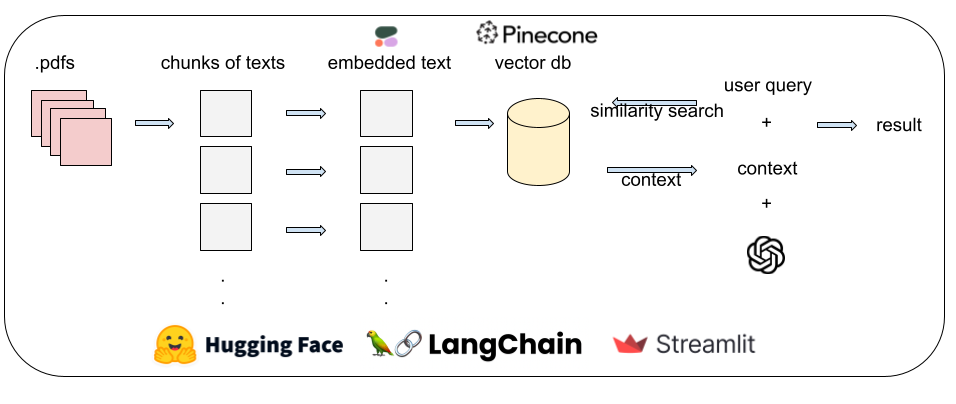- Published on
How I used RAG based LLM to help me with my course projects on Applied Machine Learning (STA5635 )
- Authors
- Name
- Mohit Appari
- @moh1tt
RAG, LLMs, Langchain, OpenAPI, Pinecone, VectorDBs sounds like a lot of jargon, right? Well, it is! But don't worry, I will explain everything in this blog post and by the end of it you should be able to build and deploy your very own LLM built on top of your custom data. Thanks to Krish Naik for such informative article on Langchain.
This blog is gonna be a practical walk through on building a RAG based LLM using OpenAI and Pinecone. If you wanna delve deeper and get a better understanding of behind the working of RAG based LLMs QA Bots I suggest looking at my other blog post on Behind the scenes of a RAG based LLM powered QAChatBot - LangChain - GPT4.
So, Let's get started!
About the project

This project is going to have a RAG based architechture where we will query our question to the LLM with some context on our own data as well and few system prompts.
To keep up with the project, you can download or clone my github repo.
Setting up the environment
To begin with, let's get all the required libraries and accounts that are gonna be used in this project.
- We're gonna create a
virtual environmentusing
python3 -m venv venv
source venv/bin/activate
- Then we're gonna create a
requirements.txtfile
langchain
langchain_openai
openai
huggingface_hub
pinecone-client
ipykernel
pypdf
langchain_community
cohere
streamlit
These are the libraries required for this project. Add them to the requirements.txt file and install them using
pip install -r requirements.txt
- We're gonna be using OpenAI's API for the LLM and Pinecone DB for storing the data. Also we're gonna need Cohere to embed our data. So, you need to have an account on these platforms. To store and access these keys in a safe way, we would create a
.envfile.
OPENAI_API_KEY=
PINECONE_API_KEY=
PINECONE_INDEX_NAME=
COHERE_API_KEY=
PINECONE_ENVIRONMENT=
These are the environment variables that we'll be using.
- Create accounts on OpenAI, Pinecone and Cohere. Once you have the accounts, you can get the API keys and store them in the
.envfile.
Now that we have our environment setup, let's move on to the next step.
Ingesting the data from your files.
In my case, the data I had were a bunch of pdfs. Lecture notes and slides that we're provided by our professor. The data can be in any format, it can be a csv, json, pdf, txt, apis etc.
The architecture that we're gonna follow can be seen below.

For this project, We're gonna use pypdf to extract the text from the pdfs and then we're gonna use cohere to embed the data.
# Extracting texts from pdfs
# Reading pdfs
def read_pdf(file_path):
loader = PyPDFLoader(file_path)
documents = loader.load_and_split()
return documents
# Process pdfs
def process_documents(documents):
doc_text = ''
for doc in documents:
text = doc.page_content
# preprocess
text = clean_text(text)
doc_text += text
return doc_text
# Preprocess the text
def clean_text(text):
# Replace newline characters with spaces
text = text.replace('\n', ' ')
# Remove unknown characters
text = ''.join(c for c in text if unicodedata.category(c) != 'Co')
# Remove extra whitespace
text = re.sub(r'\s+', ' ', text).strip()
# Remove non-alphanumeric characters
text = re.sub(r'[^a-zA-Z0-9\s]', '', text)
# Convert to lowercase
text = text.lower()
return text
# Load and process all PDF files in the the directory
pdf_dir_path = "pdfs/"
all_texts = []
for filename in os.listdir(pdf_dir_path):
if filename.endswith(".pdf"):
file_path = os.path.join(pdf_dir_path, filename)
documents = read_pdf(file_path)
texts = process_documents(documents)
all_texts.append(texts)
The above code is gonna give us all the texts as a list of texts from pdfs.
once we have all the text we need, we move on to embed them.
Embedding the data
There are many ways to embed data, one way is to use OpenAi's embedding but for this project we're gonna use Cohere as mentioned in pinecone's documentation.
# Create embeddings
def embed(text):
embeds = co.embed(
texts=text,
model='embed-english-v3.0',
input_type='search_document',
truncate='END'
).embeddings
return embeds
# Create embeddings
embeds = embed(all_texts)
The above code is gonna give us the embeddings of the data. To know more about embeddings and how they work, you can visit Cohere's documentation.
Upserting the data to Pinecone
Once we have the embeddings, we can upsert the data to Pinecone. You can follow the documentation provided on pinecone.
# Uploading data in batches
# Define the "index" variable here or make sure it is accessible in the current scope
batch_size = 128
ids = [str(i) for i in range(shape[0])]
# create list of metadata dictionaries
meta = [{'text': text} for text in all_texts]
# create list of (id, vector, metadata) tuples to be upserted
to_upsert = list(zip(ids, embeds, meta))
for i in range(0, shape[0], batch_size):
i_end = min(i+batch_size, shape[0])
index.upsert(vectors=to_upsert[i:i_end])
# let's view the index statistics
print(index.describe_index_stats())
We try to upsert in batches to avoid large uploads and cause errors. Also, be sure to check the index dimensions because you have to create and specify them when creating an index in pinecone.
To check the dimensions, you can use the following code.
import numpy as np
shape = np.array(embeds).shape
print(shape)
This tells us the dimensions of the embeddings that will be created.
Now that we have our database ready, we can move on to the next step.
Creating the RAG based LLM
Now all we have to do is query user's question based on the context retrieved from the similarity search from pinecone and the system prompts.
# RAG prompt
template = """Answer the question based only on the following context:
{context}
Question: {question}
"""
prompt = ChatPromptTemplate.from_template(template)
# RAG
model = ChatOpenAI(temperature=0, model="gpt-4-1106-preview")
chain = (
RunnableParallel({"context": retriever, "question": RunnablePassthrough()})
| prompt
| model
| StrOutputParser()
)
The chain above makes us chain the retriever which is the context, prompt which is the question and model which is the LLM.
If everything went well, you would successfully have created a RAG based LLM. We can query our question using,
chain.invoke("""Are the hidden states of the Hidden Markov Model discrete or continuous?
Continuous
Could be either discrete or continuous
Discrete""")
Deployment
To deploy my app, I used streamlit to quicky create a web app and hosted it on hugging space.
The code for streamlit can be found on my github repo as app.py. Be sure to add a gitignore and save your keys from getting exposed!
Happy Learning! 🚀